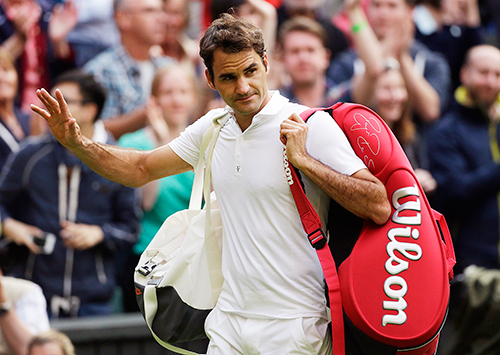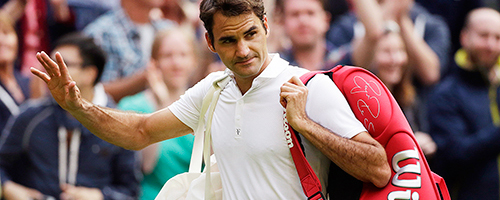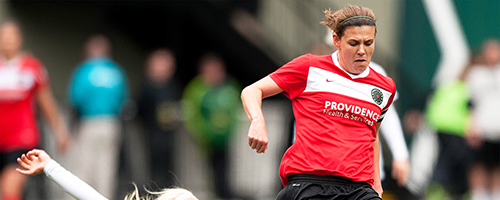Nine years. When Roger Federer lost in the second round at Wimbledon last week, it marked the first time in 36 consecutive Grand Slam tournaments that he failed to make it to the quarterfinals. At four majors per year, that’s nine years—nine years of arriving fit and hungry at the sport’s most important tournaments, sometimes coasting and sometimes struggling, working through the awkward matchups, drops in form, and illogical upsets that inevitably crop up over the course of a yearlong season. Federer came in as the defending champion at the All England Club, a venue where he has won seven titles during his career, including five in a row from 2003–07. He was seeded third, fresh off his sixth title at the grass court warm-up at Halle.
The 2nd week

Roger federer
was ousted in the second round at Wimbledon, his first loss before the quarterfinals at a Grand Slam event since Roland Garros in 2004. Photo by © AP/Anja Niedringhaus
Nine years.
When Roger Federer lost in the second round at Wimbledon last week, it marked the first time in 36 consecutive Grand Slam tournaments that he failed to make it to the quarterfinals. At four majors per year, that’s nine years—nine years of arriving fit and hungry at the sport’s most important tournaments, sometimes coasting and sometimes struggling, working through the awkward matchups, drops in form, and illogical upsets that inevitably crop up over the course of a yearlong season. Federer came in as the defending champion at the All England Club, a venue where he has won seven titles during his career, including five in a row from 2003–07. He was seeded third, fresh off his sixth title at the grass court warm-up at Halle.
Sergiy Stakhovsky, a 27-year-old Ukrainian with four titles to his name, arrived at Wimbledon with a ranking of 116. He got through his first-round encounter in straight sets and was rewarded with a meeting with a 17-time major champion. It was the sort of match that has become the closest thing to a formality in tennis over the last decade, the sort of match that Federer has spent the bulk of his career figuring out how to survive. But after nine years of tenured residency in the second week, after all the close calls against stubborn qualifiers, heedless wildcards, perversely obstinate journeymen and early round floaters at four majors and on three different surfaces, there was bound to be one who caught sight of the finish line and actually made it there before Federer found a way to prevent it. Everyone has a limit; Federer’s limit came to him from Kiev.
Now that the streak is at an end, Federer’s stretch of quarterfinal appearances at the majors can finally be put into proper perspective—because unlike most other newsworthy accomplishments in sports,
Federer wasn’t chasing another player’s mark or trying to put some distance between himself and second place. This record got out of hand a while ago.
Before Federer decided to ignore the limits of surface and style on his romp through the ATP calendar, Ivan Lendl—the prototype for the species of endurance runners and soccer refugees that dominates the tour today—was in first place on the list of consecutive Grand Slam quarterfinals. He had 14. It’s worth noting that Lendl also held the record for consecutive semifinals with 10 at the time of his retirement, a mark that Federer improved to 23 before losing to Robin Soderling in the quarters at Roland Garros in 2010. Since then, Novak Djokovic has moved into second place on both lists with 17 straight quarterfinals and 12 straight semifinals. It’s nothing less than a historic run by the current world No. 1, and it will scarcely be discussed unless he keeps doing it for another five years.
Federer won’t be around this week to defend his Wimbledon title. At 31, it’s unclear how many more realistic chances he’ll have at the majors. Ultimately, though, whether or not he adds to his Grand Slam total won’t matter all that much. The titles, after all, are merely the outcome—they don’t tell the whole story, and they certainly don’t define the Swiss legend’s lasting influence on the sport.
Federer has taken home 17 majors over the last 10 years, and he has accomplished this with overwhelming talent, tactical insight and adaptability. But that’s not how he did it. He got to 17 because he forced himself into the conversation for nine straight years, worked through the minor mechanical problems and nagging injuries and moments of doubt, gave himself a shot at the title every single time he showed up. If you consistently put yourself in a position to win, it stands to reason that every now and then you will. Roger Federer just lost in the second round at Wimbledon, and the U.S. Open is less than three months away.




